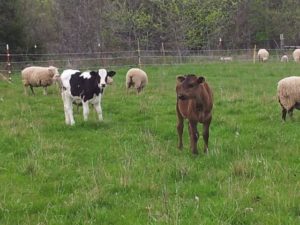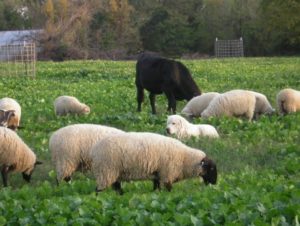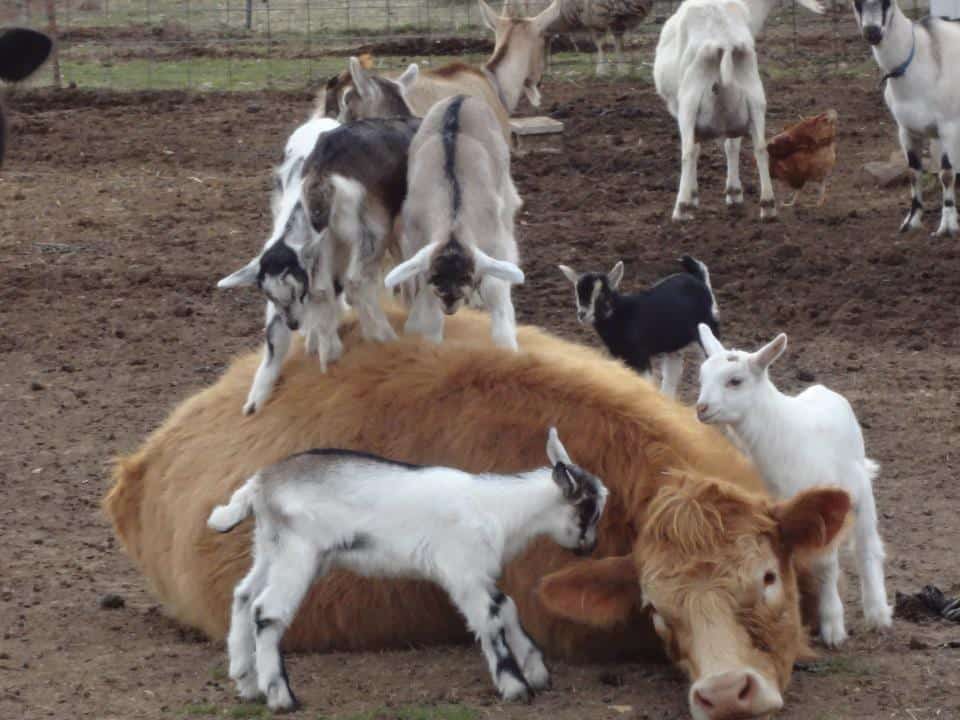Add Diversity to Your Pastures with Multispecies Grazing
Much has been written on diversity of crops, forages, and soil biology but the diversity of grazing species is just as important.
“The presence of multiple species of large herbivores is the typical condition of grassland and savanna ecosystems,” says John Walker, a range ecologist who wrote on the subject more than two decades ago (Walker, 1994). By contrast, I was taught in college to plant one or two species of pasture forages and graze them continuously with a single livestock species. If you drive around the countryside this is generally what you still see: a closely grazed pasture with leggy tufts of mature stalks from less-palatable plants, and cattle or sheep scattered over the area, repeatedly selecting the newest growth and bringing selection pressure to bear in causing the eventual demise of the best forages. This paradigm, though prevalent, is changing.
Multispecies grazing takes full advantage of biological diversity. Farmers who work hard to increase pasture-plant diversity will also see an even greater ecological and financial advantage by adding diversity of livestock to the mix.
Ecological Resiliency and Better Pasture Health
Multispecies grazing works best when a multitude of forage species comprise the pasture. “Vegetation can maintain a stable composition under higher foraging pressure when two herbivores rather than one are used to stock a pasture” write Anderson et al. (2012). As vegetation of pastures becomes more diverse, multispecies grazing tends to improve composition and utilization. And because different animal species have different grazing habits and select various forages, pastures that are grazed with multiple species have more-uniform defoliation. This uniformity of grazing contributes greatly to forage quality and resiliency by keeping forage growth constant; resetting the plants to the same stage of growth with each grazing event and preventing unpalatable plants from taking over.
Multispecies Grazing Increases Carrying Capacity
Anderson et al. (2012) note that this management practice “may be one of the most biologically and economically viable systems available to producers, especially on landscapes that support heterogeneous plant communities.”
Studies have shown that when you add sheep to a cattle herd, you get 20 to 25% greater productivity and carrying capacity over cattle alone, and 8 to 9% greater productivity and carrying capacity over sheep alone (Walker, 1994).
Your stocking rate will likely vary from season to season. It will change depending on temperature, rainfall, pasture composition, animal growth rates, and many other factors. Greg Brann, a multispecies grazier in Tennessee and a retired NRCS professional, suggests matching the livestock stocking ratio to the vegetation that livestock prefer. He’s found that a 1:1 or 1:2 ratio of sheep to cattle works well (Brann, 2018). Also, remember that sheep and goat herds grow more quickly than cattle herds. Within a few months you can easily go from 50 sheep to 150 sheep, and this will place added pressure on your pastures. Be sure to take this increasing herd size into account when you are planning your grazing.
Parasite Control
Combined with an integrated parasite-management plan, grazing multiple species together or in sequence can reduce parasite populations, due to timing of grazing and the characteristics of the parasites that infect each species of livestock. Given that sheep parasites do not usually affect cattle, cattle can be used to break the life cycle of sheep and goat parasites (and vice versa, generally).
Managing sward height is key to controlling internal parasites. As worm larvae emerge, they travel up the leaf blades of grasses to position themselves right in the way of a grazing animal as it eats, but they usually don’t climb higher than four inches. As long as you keep grazing to the top leaves of the sward, and move the animals before they graze too low, you can significantly reduce infection. Try to maintain at least a 6-inch residual after grazing. Also, give the paddocks a nice long recovery period. This is not only good for pasture health and resiliency; it also allows parasites to die off in the pasture before they can be consumed by a grazing animal. Use a 40-day recovery period— at the very least—in pastures you know to be infected by parasite larvae.
In addition, you can also use a shorter grazing period. This works to break the parasite’s life cycle. If you keep your grazing period at less than four days, your animals will be moved off the paddock before the larvae can move up into the sward to be consumed by animals.
You’ll never be able to completely eradicate internal parasites in livestock. However, an integrated management system with combined livestock species can certainly make a dent in their populations. There will always be some parasites in a herd or flock, and otherwise-healthy animals can deal with a slight parasite load. Additionally, cattle can usually handle parasites much better than small ruminants. The goal is to manage the parasites that remain in a herd such that treatments can be effective against them.
Predator Control
USDA researchers have noticed that when small ruminants are bonded to cattle to form one herd they tend to remain together, which provides safety from predators and results in less time required to check on livestock. Bonding species imparts many more benefits, as well. Cattle fencing can work very well for sheep when the sheep are bonded to cattle, and grazing distribution is enhanced, as sheep and goats tend to “spread themselves more evenly over the landscape during foraging compared with non-bonded flocks,” (Anderson et al., 2012).
Fencing is probably the most critical and challenging component of multispecies grazing from a practical standpoint, and is a crucial question given the size and behavioral differences between livestock species. Your fencing should serve multiple purposes. It should deter predators and keep your animals off the highway or out of the neighbor’s garden. And you’ll be using your fencing as a tool to control grazing in specific areas for specific animals.
The ability to exclude predators with fencing depends upon the predator species and the intensity of predatory attempts on the herd. If predator pressure is low, a woven fix-knotted wire fence will suffice. The fixed knots on the wire prevent slippage when a predator (or a sheep) tries to push through. However, with more predator pressure, a fix-knotted high-tensile woven-wire fence with fiberglass posts should be used and powered with a high-joule charger. A 30- to 50-joule charger is not unwarranted, because you want to instill fear of the fence in any predator that encounters it. Dave Scott, an ATTRA specialist and sheep rancher in Montana, recommends that producers with high predator pressure buy a charger that is twice the joule rating of what they initially think they need. A really hot wire fence is sometimes is the only way to deter predators like coyotes and bears.
There is safety in numbers, and an intensively managed multispecies herd will be less bothered by predation. However, this depends in part on the type and number of predators. Where predatory pressure is high, it may be necessary to use guardian dogs. Livestock guardian dogs must be bonded with the livestock they are guarding. If you have multiple species and are running a very diverse operation, it is important that the dogs are bonded with each one of the species. Your “sheep” dog should be calm around cattle, and not chase the chickens or harass the pigs.
Before acquiring a livestock guardian dog, do some research to decide what breeds will work best for you. Do not be tempted to pick up a “free” dog of mixed breed, if some of that “mix” is a guardian dog breed. Mixing the instincts of guarding with herding will usually be a problem. However, it’s fine to mix two or more guardian breeds (such as Anatolian Shepherd and Great Pyrenees). Having guardian dogs adds cost to the operation, but in some situations, it would be impossible to raise livestock without these protectors.
Multispecies grazing requires matching animals to the landscape and having the right fencing and working facilities. You’ll need to manage parasites and predation, and determine an accurate stocking rate to use the pasture resource efficiently. With these principles in mind, combining multiple species on pasture can be successful, profitable, and fun.
This article has been adapted from the ATTRA publication Multispecies Grazing: A Primer on Diversity (2018), by Lee Rinehart. Download the publication at https://attra.ncat.org/publication/multispecies-grazing-a-primer-on-diversity/
Lee Rinehart has been writing and educating on sustainable agriculture for over 20 years. A graduate of Texas A&M University and a Program Specialist for NCAT’s ATTRA Sustainable Agriculture program, his work focuses on agronomy, livestock, and grazing. Lee can be reached at 479-587-3474 or lee@ncat.org.
References:
Anderson, Dean, E. L. Fredrickson, and Rick Estell. 2012. Managing livestock using animal behavior: Mixed-species stocking and flerds. Animal. Vol. 6, No. 8.
Brann, Greg. 2018. Email communication.
Hart, Steve. 2014. Parasite Control with Multispecies and Rotational Grazing. Langston University.
Walker, John. 1994. Multispecies grazing: The ecological advantage. Sheep Research Journal, Special Issue.
For more information:
The ATTRA Sustainable Agriculture Program has served as the premier source of information about sustainable agriculture for U.S. farmers and other agriculturists for more than thirty years. Visit the ATTRA website at https://attra.ncat.org/.
Interested in finding out more about grazing management? ATTRA features publications, grazing calculators, and managed grazing tutorials at https://attra.ncat.org/publication/pasture-rangeland-and-adaptive-grazing/. You can also speak to an ATTRA Agriculture Specialist to discuss your grazing, pasture management, and livestock questions by calling the ATTRA hotline at 800-346-9140.





Multispecies grazing takes full advantage of biological diversity. Those farmers who work hard to increase pasture-plant diversity will also see an even greater advantage by adding diversity of livestock to the mix.
Expanding grazing to multiple species not only enriches pasture biodiversity but also enhances ecological resilience offering a sustainable approach to livestock management.
Landscape Redesign Services in Conway